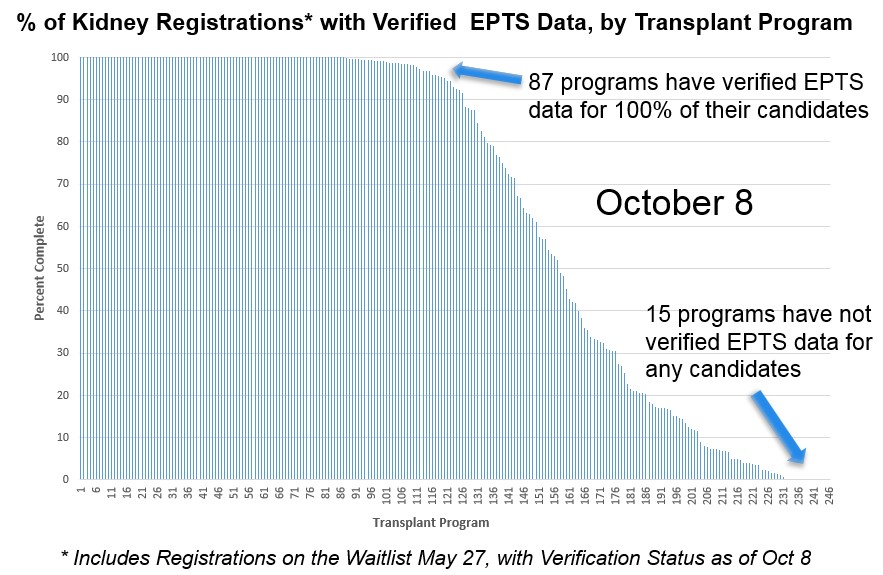Kidney allocation system status update for transplant centers and labs - October 2014
Published on: Monday, October 13, 2014
The new OPTN kidney allocation system (KAS) will be implemented on Thursday, December 4, 2014. As a follow-up to our August KAS update, The following information includes current status updates on KAS preparation, upcoming training opportunities, and resources available to help members prepare for implementation.
Status of candidate data entry/verification
To prepare for KAS implementation, kidney transplant programs will need to have the following data fields entered or verified for all current transplant candidates or entered for each new candidate registration in order to calculate an estimated post-transplant survival (EPTS) score:
- Date of birth
- Date of initiation of regularly administered dialysis for ESRD
- Number of previous solid organ transplants (new field)
- Current diabetes status (new field)
The additional fields to collect this information were added to the UNet Waitlist application on May 27. In addition, to ease the burden on transplant centers, an EPTS Data Verification Report and EPTS Data Collection tool were made available to highlight candidate records that still need data entry and/or verification. These tools can be used to update candidate information one at a time, or in batch mode using Microsoft Excel.
As of October 8, 2014, EPTS data entry or verification has been completed for 68,735 of 108,167 candidate registrations, representing 64 percent of the current kidney waitlist. Also, 9,180 kidney registrations had a CPRA of 99 or 100 percent, and 2,460 (27 percent) have both approver names entered into UNet as is required to receive increased sharing priority in the new system.

Data entry/verification reminders and clarification
Although patients without verified EPTS data will still appear on match runs, it is still critical for you to verify their EPTS data prior to December 4, 2014, to ensure each patient receives appropriate prioritization in the new system. An accurate dialysis start date is needed so that patients are assigned the correct amount of waiting time points. Patients without verified EPTS data will not receive allocation priority assigned to patients in the top 20 percent of EPTS under the new system. By default, these patients will be assumed to be outside of the top 20 percent. Although pediatric candidates will not need an EPTS score until they turn 18, programs are encouraged to enter and/or verify EPTS data fields for pediatric candidates in advance of December 4.
Starting on December 4, candidates with CPRA of 99 or 100 percent will receive regional and national sharing priority for kidney offers, but only if the unacceptable antigens listed in UNetSM have been reviewed and approved by both the transplant surgeon (or physician) and lab director, and if these approvals have been documented in the patient's medical record. Both approver names must also be entered into UNet on the candidate's waitlist record. If you intend for these candidates to be granted additional sharing priority, please be sure all of your CPRA 99 and 100 percent candidates have approver names entered to ensure they receive the maximum allowable priority. As in the EPTS Data Verification Report, UNet now also allows you to access a CPRA Approvers Report that flags candidate records where one or both approver names are missing.
Also beginning December 4, each candidate will be required to have maximum acceptable KDPI values listed on their waitlist record. The maximum acceptable KDPI value can be set differently for local vs. import offers, and for zero-ABDR mismatch vs. non-zero mismatch offers. For candidates listed prior to May 27, these values were set to 100 percent for candidates listed to receive an expanded criteria donor (ECD) kidney and 85 percent for those listed only for standard criteria donor (SCD) kidneys. Though most centers are entering these values when adding new candidates, some candidates still have missing maximum KDPI values. Any candidates with missing values on or after December 4 will be defaulted to 100 percent if listed for an ECD and 85 percent if not listed for an ECD.
In addition to EPTS data verification, approver names for CPRA 99 and 100 percent, and maximum KDPI values, transplant programs can also prepare for the December 4 implementation by ensuring that blood type B candidates that meet the center's titer criteria for accepting blood subtype A2 (i.e., A, non-A1) or A2B (i.e., AB, non-A1B) kidney offers are marked as eligible in UNetSM. To ensure patient safety, this eligibility will expire and must be reconfirmed every 90 days for those candidates that continue to meet center-specific criteria. Reporting consenting blood type B candidates as A2/A2B eligible may reduce their waiting time for a kidney; however, it is important to recognize that listing patients as eligible for A2/A2B kidneys is optional.
Training and resource information
A Clinician's Guide to KDPI has recently been posted on the OPTN website to help transplant centers discuss KDPI with their patients and determine appropriate acceptable values for offer screening. Transplant programs can also access via UNetSM an individualized Kidney Candidate Points Report that will allow them to see how their candidates rank according to the new system once their data updates are complete.
To help patients understand the new system, a new e-learning module, "The Kidney Transplantation System: What Patients Need to Know" is now available.
Access KAS resources and educational recordings. These resources will help transplant program directors, administrators and staff become familiar with the specifics of the policy and expectations for policy compliance and documentation. Your UNOS Regional Administrator can also help address additional questions or needs.



